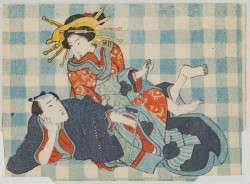
Originally published on metropolis.co.jp on September 2010
You don’t know manga. Not like this. A factory worker dabbles in chimpanzee courtship. A woman gives birth to a litter of puppies, which she and her partner try to raise as normal children. A schoolboy explodes in a cloud of maggots, a town becomes overrun with giant mushrooms, and two brothers resolve an existentialist debate through defecation.
These are just a few of the stories that crop up in an arresting new anthology, AX Vol. 1: A Collection of Alternative Manga, which compiles highlights from the first dozen years of Japan’s premier underground manga periodical. Although a few of the artists featured have already been published overseas, notably Yoshihiro Tatsumi and Takashi Nemoto, the majority are appearing in English for the first time.
“Manga should be independent, it should be open, and it should be experimental—that’s the motto of AX,” says Sean Michael Wilson, a Kumamoto-based comic-book writer who edited the collection. “The key thing is that the artist can do whatever they want to do, without strong control by an editorial force, or a consideration of financial strategy.”
Postwar pioneers like Osamu Tezuka had barely begun to establish the language of modern Japanese manga before others began to tinker with it, dragging the form into weirder, decidedly more adult territories. In the same way that Western artists insisted on the term “graphic novel” to characterize their more mature and ambitious works, their Japanese counterparts hit on the term gekiga, literally “dramatic pictures.”
These found a dedicated home in Garo, the monthly periodical started by Katsuichi Nagai in 1964. Though it would peak commercially in 1971, riding on the popularity of Sanpei Shirato’s The Legend of Kamui, the magazine continued to enjoy a cult following for a few decades after that. Nagai’s demise in 1996 sent Garo into its death throes, and key staff walked out the following year, establishing publishing company Seirin-Kogeisha. The first edition of AX appeared in February 1998, and it has continued on a bimonthly basis ever since.
“AX may not sell more than a few thousand copies, and there are other alternative outlets from the big players to go to,” writes British comic-book doyen and manga historian Paul Gravett in his foreword, “but there is still a need for freedom, for a platform for nonconformist, subversive, even transgressive manga, for new voices or for more established authors to cut loose and try something different.”
Perhaps inevitably, the end results aren’t to everybody’s tastes. Though it has been enthusiastically received at international comic conventions, AX Vol. 1 has also drawn flak from some readers on account of its, shall we say, coarser elements. The female protagonist of Saito Yunosuke’s “Arizona Sizzler” is tormented by a colossal—and very well-endowed—man, while Takashi Nemoto’s contribution, “Black Sushi Party Piece,” features a serial masturbator and a futon bristling with human penises.
“That scatological, toilet-type humor is quite familiar in Britain, for British people,” says Wilson, who originally hails from Edinburgh. “It never occurred to me that this could be in some way offensive.” At the same time, he takes umbrage at the “implication in some critics’ minds that the book would have been better without such things.”
“We can’t say ‘independent, open and experimental, but don’t put any toilet humor in, please.’ It’s not gonna work. Either it’s open or it’s not.”
Wilson, who worked closely with AX editor Mitsuhiro Asakawa in producing the collection, is quick to give credit where it’s due. “Asakawa-san is really the spring that most of this stuff is coming from,” he says. “I was only slightly involved in the compilation process, because he knows it far better than me—there’s no point in me getting in the way. So it was a mixture of what he considered to be the best, and what he considered to be representative, as a start.” The anthology took two years to complete, but he is confident they’ll be able to produce one on an annual basis in the future.
They certainly aren’t short on material. “It’s really just the tip of the iceberg,” he says. “This is only about 5 percent of what’s come out in AX so far, or less—maybe 2.7 percent or something. I’ll get my calculator out…”
Wilson is an interesting character himself. He had already published a couple of books in the UK, including an anthology of new manga, prior to moving to Japan. His work since then has ranged from yaoi (“boys love”) manga to adaptations of A Christmas Carol and Sweeney Todd, and on to the documentary-style Iraq: Operation Corporate Takeover. Most recently, he’s been working with Kodansha International on a manga version of definitive samurai text Hagakure, with artwork by Japanese cartoonist Chie Kutsuwada. Who, er, lives in London.
Like much of the work featured in AX Vol. 1, his oeuvre raises some inevitable questions. Notably: where do you draw the line about what actually qualifies as manga?
“There’s kind of like this idea that, ‘What’s art? Art is what you stick in a gallery,’” Wilson says. “What’s manga? Manga is what a Japanese person does… I’ve read various things where people get obsessed with this is and this is not manga. I don’t think it’s so important—let’s just enjoy this individual production as a good thing or bad thing.”
[slideshow id=11 w=500]
 AX Vol. 1: A Collection of Alternative Manga edited by Sean Michael Wilson (Top Shelf Productions, 2010, 400pp, ¥2,710) is available now from select bookstores and via Amazon Japan.
AX Vol. 1: A Collection of Alternative Manga edited by Sean Michael Wilson (Top Shelf Productions, 2010, 400pp, ¥2,710) is available now from select bookstores and via Amazon Japan.
Hagakure: The Code of the Samurai (The Manga Edition) comes out this month.











